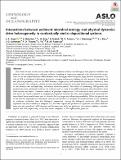Interactions between sediment microbial ecology and physical dynamics drive heterogeneity in contextually similar depositional systems
Abstract
This study focuses on the interactions between sediment stability and biological and physical variables that influence the erodibility across different habitats. Sampling at short‐term temporal scales illustrated the persistence of the microphytobenthos (MPB) biomass even during periods of frequent, high physical disturbance. The role of MPB in biological stabilization along the changing sedimentary habitat was also assessed. Key biological and physical properties, such as the MPB biomass, composition, and extracellular polymeric substances, were used to predict the sediment stability (erosion threshold) of muddy and sandy habitats within close proximity to one another over multiple days, and within emersion periods. The effects of dewatering, MPB growth, and productivity were examined as well as the resilience and recovery of the MPB community after disturbance from tidal currents and waves. Canonical analysis of principal components (CAP) ordinations were used to visualize and assess the trends observed in biophysical properties between the sites, and marginal and sequential distance‐based linear models were used to identify the key properties influencing erodibility. While the particle size of the bed was important for differences between sites in the CAP analysis, it contributed less to the variability in sediment erodibility than key biological parameters. Among the biological predictors, MPB diversity explained very little variation in marginal tests but was a significant predictor in sequential tests when MPB biomass was also considered. MPB diversity and biomass were both key predictors of sediment stability, contributing 9% and 10%, respectively, to the final model compared to 2% explained by grain size.
Citation
Hope , J , Malarkey , J , Baas , J , Peakall , J , Parsons , D , Manning , A J , Bass , S , Lichtman , I , Thorne , P , Ye , L & Paterson , D M 2020 , ' Interactions between sediment microbial ecology and physical dynamics drive heterogeneity in contextually similar depositional systems ' , Limnology and Oceanography , vol. 65 , no. 10 , pp. 2403-2419 . https://doi.org/10.1002/lno.11461
Publication
Limnology and Oceanography
Status
Peer reviewed
ISSN
0024-3590Type
Journal article
Description
This work was supported by the UK Natural Environment Research Council (NERC), grant NE/I027223/1 (COHBED). D.M.P. received funding from the Marine Alliance for Science and Technology for Scotland (MASTS), funded by the Scottish Funding Council (grant HR09011). J.M. and D.R.P. were partially funded by a European Research Council Consolidator Award (725955).Collections
Items in the St Andrews Research Repository are protected by copyright, with all rights reserved, unless otherwise indicated.

